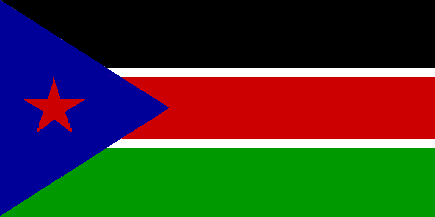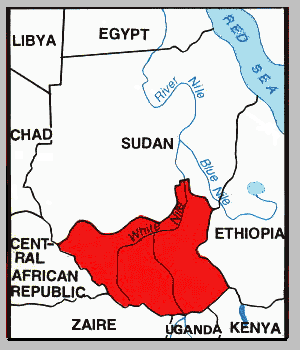





 With the exception of a fragile peace established by negotiations between southern Sudanese insurgents (the Anya Nya) and the Sudan government at Addis Ababa in 1972, and lasting until the resumption of the conflict in 1983, southern Sudan has been a battlefield. The north-south distinction and the hostility between the two regions of Sudan is grounded in religious conflict as well as a conflict between peoples of differing culture and language. The language and culture of the north are based on Arabic and the Islamic faith, whereas the south has its own diverse, mostly non-Arabic languages and cultures -- with few exceptions non-Muslim, and its religious character was indigenous (traditional or Christian).
With the exception of a fragile peace established by negotiations between southern Sudanese insurgents (the Anya Nya) and the Sudan government at Addis Ababa in 1972, and lasting until the resumption of the conflict in 1983, southern Sudan has been a battlefield. The north-south distinction and the hostility between the two regions of Sudan is grounded in religious conflict as well as a conflict between peoples of differing culture and language. The language and culture of the north are based on Arabic and the Islamic faith, whereas the south has its own diverse, mostly non-Arabic languages and cultures -- with few exceptions non-Muslim, and its religious character was indigenous (traditional or Christian).
The origins of the civil war in the south date back to the 1950s. On August 18, 1955, the Equatoria Corps, a military unit composed of southerners, mutinied at Torit. Rather than surrender to Sudanese government authorities, many mutineers disappeared into hiding with their weapons, marking the beginning of the first war in southern Sudan. By the late 1960s, the war had resulted in the deaths of about 500,000 people. Several hundred thousand more southerners hid in the forests or escaped to refugee camps in neighboring countries. By 1969 the rebels had developed foreign contacts to obtain weapons and supplies. Israel, for example, trained Anya Nya recruits and shipped weapons via Ethiopia and Uganda to the rebels. Anya Nya also purchased arms from Congolese rebels. Government operations against the rebels declined after the 1969 coup, and ended with the Addis Ababa accords of 1972 which guaranteed autonomy for the southern region.
The civil war resumed in 1983 when President Nimeiri imposed Shari'a law, and has resulted in the death of more than 1.5 million Sudanese since through 1997. The principal insurgent faction is the Sudan People's Liberation Movement (SPLM), a body created by the Sudan People's Liberation Army (SPLA). The SPLA was formed in 1983 when Lieutenant Colonel John Garang of the SPAF was sent to quell a mutiny in Bor of 500 southern troops who were resisting orders to be rotated to the north. Instead of ending the mutiny, Garang encouraged mutinies in other garrisons and set himself at the head of the rebellion against the Khartoum government. Garang, a Dinka born into a Christian family, had studied at Grinnell College, Iowa, and later returned to the United States to take a company commanders' course at Fort Benning, Georgia, and again to earn advanced economics degrees at Iowa State University. By 1986 the SPLA was estimated to have 12,500 adherents organized into twelve battalions and equipped with small arms and a few mortars. By 1989 the SPLA's strength had reached 20,000 to 30,000; by 1991 it was estimated at 50,000 to 60,000.
Since 1983, the SPLA has been divided into 3 main factions: the SPLA Torit faction led by John Garang; the SPLA Bahr-al-Ghazal faction led by Carabino Kuany Bol; and the South Sudan Independence Movement led by Rick Machar. These internal divisions have intensified fighting in the south, hampering any potential peace settlement. The SPLA remains the principal military force in the insurgency.
In April 1997 the South Sudan Independence Movement/Army (SSIM/A), which broke away from the SPLA, and several smaller southern factions concluded a peace agreement with the Government. These former insurgent elements then formed the United Democratic Salvation Front (UDSF). However, the SPLM, its armed wing, the SPLM/A, and most independent analysts have regarded the April 21 Agreement as a tactical government effort to enlist southerners on its side. The SPLM/A and its northern allies in the National Democratic Alliance (NDA) carried out successful military offensives in areas along the borders with Ethiopia and Eritrea and in large parts of the south during the year. Neither side appears to have the ability to win the war militarily.
In 1996 the US government decided to send nearly $20 million of military equipment through the 'front-line' states of Ethiopia, Eritrea and Uganda to help the Sudanese opposition overthrow the Khartoum regime. US officials denied that the military aid for the SPLA and the Sudanese Allied Forces (SAF), described as 'non-lethal' -- including radios, uniforms, boots and tents -- was targeted at Sudan. The Pentagon and CIA considered Sudan to be second only to Iran as a staging ground for international terrorism. CIA Director John Deutch made a 3-day visit to the Ethiopian capital in April 1996, where he noted that funds had been significantly increased for a more activist policy including preemptive strikes against terrorists and their sponsors. Reportedly several Operational Detachments-Alpha (also called A-Teams) of the US army were operating in support of the SPLA.
